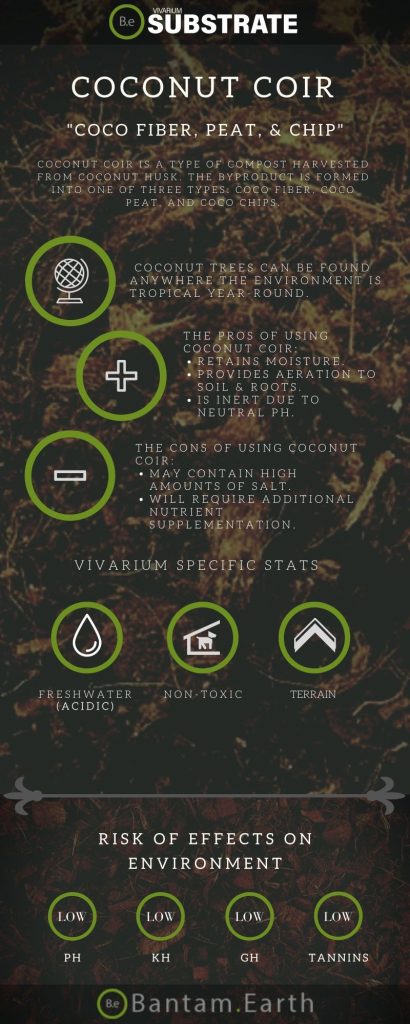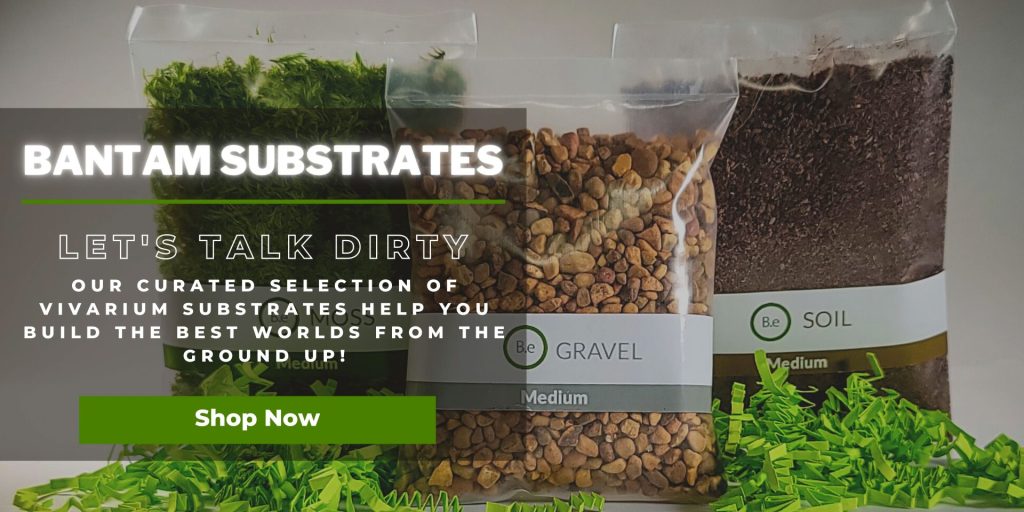Coconut Coir has become one of the most sought-after compost in the hydroponics industry.
In recent times it has found its way into the vivarium market for similar reasons.
Even though it is highly praised for various reasons, it does have its flaws.
If you are wondering if this type of substrate can be beneficial to your setup, you are in the right place.
This article will act as a complete guide for different forms of coco coir as well as illustrate its use specifically for vivarium plants and animals.
| Quick Stats: | |
|---|---|
| Technical Name | Coconut Coir |
| Common Names | Coconut Fiber, Coco Fiber, Coconut Husk Fiber, Coco Peat |
| Origin | Coconut Husk |
| Size | 4 to 12 in |
| Color | Brown |
| PH Impact | Neutral |
| Elemental Type | Cellulose fiber |
Table Of Contents:
ToggleWhat Is Coconut Coir?
Coconut coir is a type of compost harvested from coconut husk.
It is the byproduct of the coconut that many found useless and would discard until the early 19th century.
It is now commonly used to make many objects including ropes, mattresses, brushes, and doormats.
In horticulture, it has become a very popular growing media used as a standalone substrate or soil amendment.
Many hobbyists find that coconut husk can comparably be used as an alternative to sphagnum peat and in many cases prefer it.


Coconut Coir Facts
When coconut coir is converted into usable compost, the byproduct is formed into one of three types: coco fiber, coco peat, and coco chips.
Many hobbyists might commonly refer to any of all three types as simply coco fiber, but they each function in their own unique way so it’s important to know which kind you should use.
Coco fiber is a string-like material that is commonly made into mats that are great for vivarium backgrounds.
This form of coconut coir is very rich in aeration making it optimal for getting oxygen to roots when used as a substrate.
The drawback with coco fiber is it tends to break down faster than other forms of coconut coir.
Coco peat is the grounded soil-looking form of coconut coir.
Also referred to as coco pith, this material is commonly used as a growing media.
It is super absorbent which makes it great for maintaining moisture and leeching nutrients.
The drawback with coco peat is its lack of oxygen retention which can lead to suffocating roots over time.
Coco chip is the flaky wood-like form of coconut coir.
This variation of compost combines the good qualities of peat and fiber.
It can retain both oxygen and water well equally.
It is comparable to clay pellets and decomposes at a much slower rate than the other form of coco coir.
The downside to coco chips is it’s a rather large particle size in smaller vivarium setups.
Description
Coconut coir will vary in look depending on its form and maturity when harvested.
For instance, coco husk is typically a brown color when collected but more immature coconuts will have a light tan color to almost white.
As we covered earlier, coir can be groomed to a number of formations, from stringy thread-like to flaky wood chips or actual grounded soil.
Origin
As you know by now, coconut coir comes from coconuts.
Coconuts grow on coconut palm trees in areas where the environment is tropical year-round.
If you broke a fresh coconut in half, a number of layers would be revealed.
Coconut husk consumes all of the second-most inner layers just after the hard green outer shell.
The next layer just beneath the coir is a second hardened shell protecting both the edible white flesh as well as the coconut milk.
Environmental Influence
Pure coconut coir is an inert material on its own.
Even though the average pH range of coir is between 5.2 and 6.8, it won’t have any sort of effect on the water parameters of a vivarium.
On the contrary, the elements that are easily absorbed into the coir can leech out and have an influence on the enclosure.
Some manufacturers will soak coco husk in saltwater during processing causing the compost to contain high amounts of salt.
This can have a negative effect on acidic-based enclosures.
Vivarium Type
Coconut coir (peat, fiber, chip) is useful in various types of vivariums.
Depending on the setup, one might be more beneficial than another.
They all work well as substrates in land-based setups.
As far as aquatic setups, there are better options to consider for growing media despite being a known byproduct in hydroponic systems.
Here is a recommended list of vivarium types coconut coir is commonly used in:
- Paludariums – Half aquatic/ half terrain-based enclosure.
- Terrariums – Fully terrain-based enclosures with little to no aquatic features.
Vivarium Usage
When it comes to using coconut coir in any type of setup, you first need to know which form to use and why you are using it.
Some are suitable animal bedding while others can make up the majority of a substrate mix.
Furthermore, various types of coconut husk can be put together to combine the benefits of each.
Coco fiber mats can work great for creating backgrounds in vivariums.
Epiphytes and vines will easily cling to the mat further offering a space vertically to scape.
Coconut fiber is also perfect for providing bedding and a nest for small animals like hamsters or birds.
Coco chips are very popular substrates to use in amphibian and reptile enclosures.
They offer animals an easy place to burrow down into as well as a nest.
This form of coir is also ideal for plants with delicate root structures.
It provides increased aeration, moisture retention, and even drainage.
Coconut chips work well as standalone compost and are mixed in with other soils.
Coco peat is best known for its substrate capabilities in tropical biotypes.
As it hydrates, it will increase the humidity in terrariums.
This type of coco husk stimulates burrowing behavior in animals that like swampy, moist environments.
Tropical plants do well with coconut peat as compost.
Advantages
There are some pretty mouth-watering benefits to using coconut coir in a vivarium.
For starters, it is one of the most effective soils, next to sphagnum peat, for retaining moisture.
This growth media can absorb up to 10 times its weight in water.
Coir is eco-friendly and a byproduct of a resource we will virtually never deplete (unlike sphagnum peat which takes 1000s of years to form).
Furthermore, coco husk is inert and has a neutral PH that makes it safe for all biotypes.
Disadvantages
The downside to being so high in water retention is the result of high salt content.
If salt is present within coconut husk due to companies soaking it in salt water, this will have an effect on water/soil parameters in a vivarium.
In addition, coco coir lacks the necessary nutrients plants will need to reach their full potential.
Supplements like magnesium, calcium, and iron will need to be added during watering if coconut coir is being used as a sole substrate.
Buy Coconut Coir
When buying coconut coir in various forms, shop with companies that know how to properly process the compost.
Most manufacturers will soak coir in saltwater but should also rinse it in fresh water to filter out salts.
Avoid products that have been chemically treated to preserve the coir until sold.
These chemicals can have a negative effect on plant growth and the inhabitant’s health.
Click the image below to find out more about the current price and other relative info:


Coconut Coir Preparation & Usage
Preparing coconut coir for a vivarium will more than likely involve rehydrating and breaking up.
Many companies sell the product in a compressed block form to save on shipping and offer the material at a cheaper expense.
As you soak the coir in PH-neutral water, the material will begin to expand greatly.
Once prepared, simply add it to the vivarium as needed or combine it into a powerful substrate mix that will benefit that specific enclosure’s biotype.
How To Make Coconut Coir
Making your own coconut coir is a time-consuming process that will require patience.
Start by removing the outer green shell of the coconut.
Soak the bare coconut in freshwater to help loosen and soften the husk.
Using a steel comb, strip the husk from the coconut until you get down to the second hard layer.
Gather the coir material and allow it to dry out.
This process will need a couple of days to completely dry.
Once it is fully dry, chop the husk into chips or ground it into peat.
Coconut Coir Alternatives
When it comes to compost, there are an array of options one could consider.
It mainly comes down to preference and intent of use.
Coconut coir has its share of benefits, but there are downsides to using it solely.
If you’d like to see other options or looking for other grow media to combine with this compost…
Here are some good suggestions for secondary layer substrate alternatives you may consider:
Conclusion
In summary, coconut coir is absolutely great for vivarium use when combined with other compost that compensates for the few things it lacks.
It can provide aeration in clay soils as well as retain water in a sand-based substrate.
Inhabitants will use the coir as a place to rest, burrow, and even nest.
With the right nutritional balance during watering, plants will typically do better in this type of compost than many other alternatives.
Now that we have gone in-depth regarding coco coir, what are your thoughts about the material as an auxiliary layer?
Frequently Asked Questions
Coconut coir is a strong, stiff fiber that is an excellent growing media for plants. It provides great water retention and aeration, helps prevent disease–causing bacteria from developing, and helps to control pH levels. Coconut coir is often used as a substrate in hydroponic or coco–coir systems to provide the optimal environment for exceptional plant growth.
Yes, coco coir is better than peat moss. Coco coir is better for the environment, retains moisture better, resists compaction, is easy to rewet and provides a great balance of air and water for strong and healthy root systems.
A good rule of thumb is to use one part coco coir to two parts water when preparing it for use in your garden. So, if you are using a 5-gallon bucket of coco coir, you should add 10 gallons of water to it.
Yes, Coco Fiber can be used to create a bioactive terrarium. This type of substrate has good water retention, drainage, and aeration, making it an ideal material for the living environment of reptiles and amphibians. The inclusion of beneficial bacteria and fungi will help prevent pests, reduce waste, and create a balanced terrarium ecosystem.
The main disadvantage of coconut coir is its cost. As it provides more benefits and is more sustainable than traditional potting soil, it can be expensive. Additionally, coconut coir may be prone to root rot, due to the high water retention and tension of the material. It can also be difficult to work with since it is extremely light and dust–like. Finally, since it is made from coconut husks, it can attract pests such as ants, if not properly treated.





